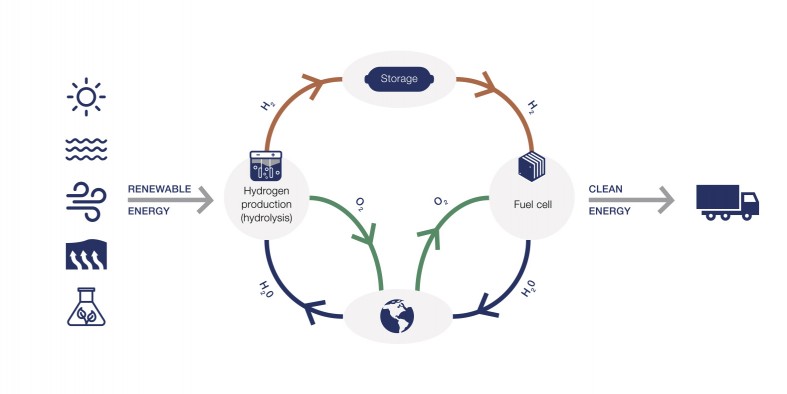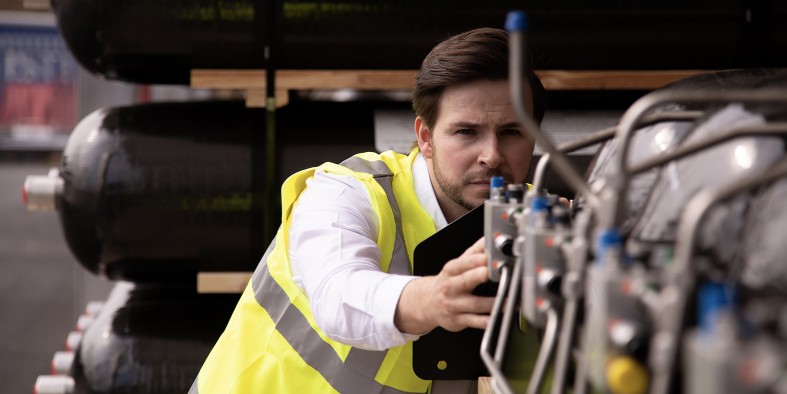US & Asia-Pacific +1 800 764 0366 | Europe & Middle East +44 (0)115 980 3800

In order to reduce our carbon emissions and look towards building a sustainable future for ourselves, the EU has adopted new HGV emission targets that are designed to meet carbon-neutrality by 2050.
It has been reported that heavy duty vehicles are responsible for around a fifth of CO2 emissions from road transport in the EU, and 6% of EU carbon emissions overall. Therefore if we want to achieve carbon-neutrality then the entire transport sector needs to change the way it operates.
One solution to help cut emissions is to replace fossil fuels with hydrogen fuel. Many people are citing hydrogen as the fuel of the future, predicting that 50,000 hydrogen-powered buses and 350,000 hydrogen-powered trucks will be on the motorways by 2030.

What are the government aims?
The objective is that by 2030 truck CO2 emissions will be cut by a third from 2019 levels with the help from green hydrogen fuel. Governments are offering up to 75% lower road tolls for fuel efficient vehicles, and introducing higher taxes and diesel ban threats on those that are not eco friendly. In addition they are working with suppliers to help fund innovative climate projects, and in the UK electric trucks and hydrogen-powered buses are set to secure nearly 10,000 UK jobs and save 45 million tonnes of carbon emissions.
As a result, a lot of leading truck-makers are investing heavily in greener fuel, and globally, hydrogen fuel cell trucks are seen as a key solution for running clean commercial vehicles.

What are hydrogen powered vehicles?
Hydrogen powered vehicles work in a similar way to gasoline powered cars, where energy is released by creating a chemical reaction. However, unlike gasoline powered cars they do not emit any vehicle emissions other than water vapour – therefore can help us secure a greener future.
There are two ways in which hydrogen powered cars can create electricity: hydrogen fuel cells or hydrogen powered engines. Fuel cell trucks are filled with hydrogen from the vehicle’s fuel tank, mixing hydrogen with oxygen to create H2O in an electrochemical process. Whereas a hydrogen-powered engines uses combustion as its chemical reaction – burning hydrogen instead of gasoline and converting the hydrogen into mechanical energy.
Are hydrogen powered trucks better than electric?
Hydrogen powered trucks are regarded as the best solution for long haul drivers, particularly vehicles travelling beyond the urban built up areas. This is largely because they overcome some of the limitations that electric vehicles face:
The main characteristics that distinguish hydrogen from electric is the short refuelling time, being able to go long distances, and pulling heavier loads uphill is sometimes a requirement of a job. It would not be practical for a truck fleet going across country to make regular stops to charge and burden the local electricity grid as it does so. That is why hydrogen is the better solution for vehicles such as: trucks, lorries, vans, refuse vehicles, class 8 and HGV, tractors and forklifts.
The pros and cons of hydrogen powered trucks and lorries
The pros
There are a lot of attractive characteristics of hydrogen powered vehicles that make them the perfect solution:
- No vehicles emissions other than water vapor
- Hydrogen is abundant and can be made from renewable energy
- Short refuelling times
- Long usage time
- Perfect for heavy loads
- Better fuel economy
- No engine noise or visual pollution
The Cons
However, hydrogen fuel cells also come with a set of challenges to overcome in order to be effective, in order for it to work it needs to be green hydrogen:
- The technology is expensive at the moment so investment is required
- The majority of energy used in the hydrogen extraction process currently comes from non-renewable sources
- Requires extremely high-pressure, on-board hydrogen storage
- Few places to refuel

How Luxfer can help
Luxfer Gas Cylinders are determined to be part of the change for a better future, setting themselves a 2025 goal to reduce CO2 emissions by 20%. One of the ways in which Luxfer can help protect the environment is by getting involved in projects involving hydrogen fuel.
Luxfer can help overcome some of the temporary limitations of hydrogen fuel by:
- Working with OEMS to make efficiencies
- Encouraging other companies to invest in renewable energy such as wave, solar, biomass, geothermal and wind
- Continue to develop gas cylinders for on-board hydrogen storage, such as the 400. Luxfer G-storTM H2 hydrogen cylinders
- Help develop the framework and pipework for seamless integration into Hydrogen powered vehicles, all adhering to stringent quality and safety regulations
One of the challenges hydrogen fuel faces is being able to store it safely. Luxfer works with many commercial vehicle managers around the world to provide them with hydrogen storage cylinders and complete fuel storage solutions, taking responsibility for safety standards and certification. Recently, Luxfer was commissioned by Hyundai to help create the first green commercial truck fleet in history.

Hyundai and Luxfer partnership
Hyundai were one of the first to commit to hydrogen as a replacement energy to fossil fuels. They have already invested heavily in it, planning to put 1,600 hydrogen trucks on the roads in Switzerland by 2025. The chief executive of Hyundai Hydrogen Mobility states that it isn’t enough to produce just one truck “we have to change the entire ecosystem”.
The multi-million-pound project integrating hydrogen fuel cell technology has recently put 50 hydrogen-powered lorries into service for a supermarket chain in Switzerland. The Hyundai Xcient Fuel-Cell trucks are the first green commercial fleet to hit the roads, and will transport supermarket deliveries across the country.
They commissioned Luxfer to provide the knowledge of a complete fuel system in order to bring their ideas to life. Dr. Mark Lawday, director at Luxfer Gas Cylinders explains: “Switzerland is an ideal market for hydrogen-powered trucks, thanks in part because the country generates more than half of its energy from hydropower, so if this can be used to generate the hydrogen then it completely eliminates emissions.
“Each hydrogen truck features a 190 kilowatt fuel cell comprised of seven high-pressure tanks holding around 35kg of hydrogen. This provides a long distance range of about 400km before refuelling is required, which far surpasses the capabilities of vehicles powered by electric.”
When speaking to drivers they commented that there was no need to change up their driving style, instead being more than impressed with the acceleration and quiet engine.
Since development began on the landmark project in Feb 2019, the Luxfer Hyundai design team have developed the framework and pipework for seamless integration into Hyundai’s vehicles, all adhering to stringent quality and safety regulations.

The future of hydrogen fuel cell trucks
With over 100,000 fuel cylinders already in use on over 18,000 vehicles around the world, it’s off to a promising start. The Hydrogen Council estimates there will be 50,000 hydrogen-powered buses and 350,000 hydrogen-powered trucks on the world’s roads by 2030.
Luxfer anticipates that hydrogen fuel cell trucks will become increasingly attractive for heavy goods transportation, as the cost of producing clean fuel drops and greener alternatives to diesel are supported with funding. In fact, Luxfer recently expanded its hydrogen facility in Nottingham, to meet the increased demand for alternative fuel solutions for the transport industry and our collective drive for a greener future. We’re dedicated to continue innovating our hydrogen fuel systems to reduce costs, improve efficiency and make storage safe and easy for all users.